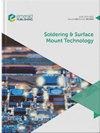Low-cycle fatigue life assessment of SAC solder alloy through a FEM-data driven machine learning approach
IF 1.8
4区 材料科学
Q3 ENGINEERING, ELECTRICAL & ELECTRONIC
引用次数: 0
Abstract
Purpose This paper aims to present the novel stacked machine learning approach (SMLA) to estimate low-cycle fatigue (LCF) life of SAC305 solder across structural parts. Using the finite element simulation (FEM) and continuous damage mechanics (CDM) model, a fatigue life database is built. The stacked machine learning (ML) model's iterative optimization during training enables precise fatigue predictions (2.41% root mean square error [RMSE], R 2 = 0.975) for diverse structural components. Outliers are found in regression analysis, indicating potential overestimation for thickness transition specimens with extended lifetimes and underestimation for open-hole specimens. Correlations between fatigue life, stress factors, nominal stress and temperature are unveiled, enriching comprehension of LCF, thus enhancing solder behavior predictions. Design/methodology/approach This paper introduces stacked ML as a novel approach for estimating LCF life of SAC305 solder in various structural parts. It builds a fatigue life database using FEM and CDM model. The stacked ML model iteratively optimizes its structure, yielding accurate fatigue predictions (2.41% RMSE, R 2 = 0.975). Outliers are observed: overestimation for thickness transition specimens and underestimation for open-hole ones. Correlations between fatigue life, stress factors, nominal stress and temperature enhance predictions, deepening understanding of solder behavior. Findings The findings of this paper highlight the successful application of the SMLA in accurately estimating the LCF life of SAC305 solder across diverse structural components. The stacked ML model, trained iteratively, demonstrates its effectiveness by producing precise fatigue lifetime predictions with a RMSE of 2.41% and an “ R 2 ” value of 0.975. The study also identifies distinct outlier behaviors associated with different structural parts: overestimations for thickness transition specimens with extended fatigue lifetimes and underestimations for open-hole specimens. The research further establishes correlations between fatigue life, stress concentration factors, nominal stress and temperature, enriching the understanding of solder behavior prediction. Originality/value The authors confirm the originality of this paper.基于有限元数据驱动机器学习方法的SAC焊料合金低周疲劳寿命评估
本文旨在提出一种新的堆叠机器学习方法(SMLA)来估计SAC305结构件焊料的低周疲劳(LCF)寿命。采用有限元模拟(FEM)和连续损伤力学(CDM)模型,建立了疲劳寿命数据库。堆叠机器学习(ML)模型在训练过程中的迭代优化可以精确预测不同结构部件的疲劳(2.41%的均方根误差[RMSE], r2 = 0.975)。在回归分析中发现异常值,表明对寿命延长的厚度过渡样品可能高估,而对裸眼样品可能低估。揭示了疲劳寿命、应力因子、名义应力和温度之间的相关性,丰富了对LCF的理解,从而增强了焊料行为的预测。设计/方法/方法本文介绍了堆叠ML作为一种估算各种结构件中SAC305焊料LCF寿命的新方法。采用有限元模型和CDM模型建立了疲劳寿命数据库。叠置ML模型对其结构进行了迭代优化,得到了准确的疲劳预测(RMSE 2.41%, r2 = 0.975)。观察到异常值:厚度过渡样品高估,裸眼样品低估。疲劳寿命、应力因素、名义应力和温度之间的相关性增强了预测,加深了对焊料行为的理解。本文的研究结果突出了SMLA在准确估计SAC305焊料跨不同结构部件LCF寿命方面的成功应用。经过迭代训练的堆叠ML模型通过产生精确的疲劳寿命预测(RMSE为2.41%,r2为0.975)证明了其有效性。该研究还确定了与不同结构部件相关的不同异常行为:对具有延长疲劳寿命的厚度过渡试件的高估和对裸眼试件的低估。该研究进一步建立了疲劳寿命、应力集中系数、名义应力和温度之间的相关性,丰富了对焊料行为预测的理解。原创性/价值作者确认本文的原创性。
本文章由计算机程序翻译,如有差异,请以英文原文为准。
求助全文
约1分钟内获得全文
求助全文
来源期刊

Soldering & Surface Mount Technology
工程技术-材料科学:综合
CiteScore
4.10
自引率
15.00%
发文量
30
审稿时长
>12 weeks
期刊介绍:
Soldering & Surface Mount Technology seeks to make an important contribution to the advancement of research and application within the technical body of knowledge and expertise in this vital area. Soldering & Surface Mount Technology compliments its sister publications; Circuit World and Microelectronics International.
The journal covers all aspects of SMT from alloys, pastes and fluxes, to reliability and environmental effects, and is currently providing an important dissemination route for new knowledge on lead-free solders and processes. The journal comprises a multidisciplinary study of the key materials and technologies used to assemble state of the art functional electronic devices. The key focus is on assembling devices and interconnecting components via soldering, whilst also embracing a broad range of related approaches.
 求助内容:
求助内容: 应助结果提醒方式:
应助结果提醒方式:


